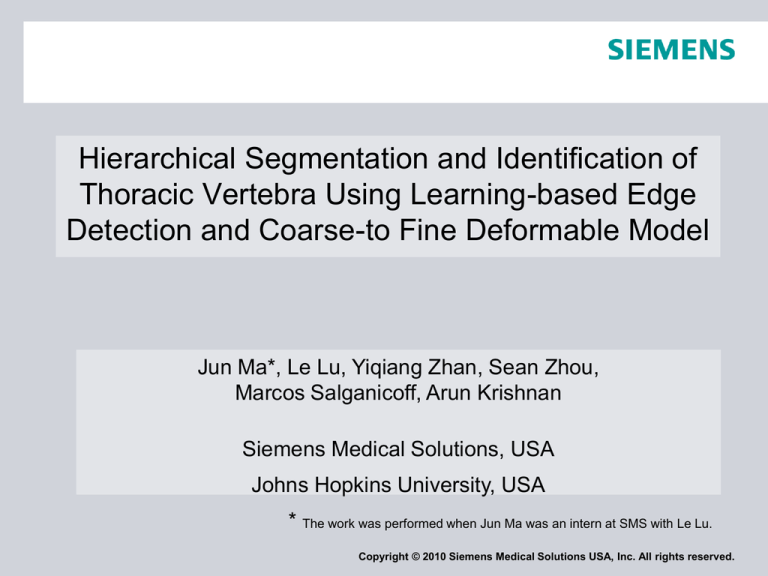
Hierarchical Segmentation and Identification of
Thoracic Vertebra Using Learning-based Edge
Detection and Coarse-to Fine Deformable Model
Jun Ma*, Le Lu, Yiqiang Zhan, Sean Zhou,
Marcos Salganicoff, Arun Krishnan
Siemens Medical Solutions, USA
Johns Hopkins University, USA
* The work was performed when Jun Ma was an intern at SMS with Le Lu.
Copyright © 2010 Siemens Medical Solutions USA, Inc. All rights reserved.
Introduction
Motivations:
- Decrease false positive of lung CAD
- Provide intelligent CAD report
- Other orthopedic, neurological and oncological use cases
Copyright © 2010 Siemens Medical Solutions USA, Inc. All rights reserved.
Related Work
Automated spinal column extraction and partitioning (Yao et.
al.)
Automated vertebra detection and segmentation from the
whole spine MR images (Peng et.al.)
Localized priors for the precise segmentation of individual
vertebras from CT volume data (Shen et.al.)
Automatic lumbar vertebral identification using surfacebased registration (Herring et. al.)
Automated model-based vertebra detection, identification,
and segmentation in CT images (Klinder et. al.)
Copyright © 2010 Siemens Medical Solutions USA, Inc. All rights reserved.
Methods Overview
Vertebrae Segmentation
Learning-based edge detector
Hierarchical deformation scheme
Vertebrae Identification
Mean Shapes
Single vertebra identification
Vertebrae string identification
Copyright © 2010 Siemens Medical Solutions USA, Inc. All rights reserved.
System Flowchart
Similarity Alignment
(Initialization via Landmarks)
Part Deformation (Articulated Moves
with Learning-based Bone Edge
Response Evaluation)
Similarity Alignment
(Initialization via Landmarks)
Run 3 times!
Mesh Gaussian Smoothing
One Round of Learning-based Bone
Edge Response Evaluation based on
Aligned Surface
Patch Deformation (Normal Moves
with Learning-based Bone Edge
Response Evaluation)
Run 4 times!
Model Fitness for Identification
Mesh Gaussian Smoothing
Segmentation Vertebra Mesh
Generation
Copyright © 2010 Siemens Medical Solutions USA, Inc. All rights reserved.
Surface template generation (training
purpose)
Original 3D
CT image
Preprocessing
Manual
segmentation
Surface
generation
Copyright © 2010 Siemens Medical Solutions USA, Inc. All rights reserved.
Edge detectors: gradient steerable features
Sampling parcel:
For a point x, take 5 neighboring sampling
points along the normal line.
Pn (I )
n
n
I
surface
Features: intensity + derivatives with different
Gaussian kernel sizes
x
Each point x has 5 * 3 = 15 features.
Sampling parcel:
Feature vector:
depends on the norm of triangle surface
Copyright © 2010 Siemens Medical Solutions USA, Inc. All rights reserved.
Edge detectors: training of edge detectors
• Training samples:
Positive: boundary parcels
Negative: interior and exterior parcels
• Add random disturbance to the ground truth surface, only points on the border
and has norm within certain range will be used as positive samples
(0.9~1.1 for scale, -10°~ 10° for rotation)
• Train LDA classifiers using combined non-disturbed and disturbed feature
vectors. Output is a probability value.
-++--+-+-+ - -- +--++----++
+
+
+
++ - --+- -
Copyright © 2010 Siemens Medical Solutions USA, Inc. All rights reserved.
Edge response map
Generate response map by learned edge detectors
- optimally combine image features to detect object-specific edge
- more discriminative and robust
- Indicates edge likelihood (probability map)
- Informative but noisy
Hierarchical deformation strategy
- Sub-region deformation
- Patch deformation
- Individual vertex deformation
Copyright © 2010 Siemens Medical Solutions USA, Inc. All rights reserved.
Sub-region deformation
Sub-region deformation
Divide the surface to 12 subregions
Vertices in the same subregion deform together as a team
Rigid transformation with the strongest “edge ” likelihood is the target position.
Calculate
Maximum
response
response
at this position
Copyright © 2010 Siemens Medical Solutions USA, Inc. All rights reserved.
Patch deformation
Patch deformation
Move a patch to a number of
positions along its normal
direction, and calculate the
responses at these positions.
Position with strongest response
is the target position.
Individual vertices deformation
Move each vertex to a position
with highest edge likelihood
Calculate
Maximum
responseresponse
at this position
Copyright © 2010 Siemens Medical Solutions USA, Inc. All rights reserved.
Results
Average Error: 1.12 mm
Copyright © 2010 Siemens Medical Solutions USA, Inc. All rights reserved.
Methods Overview
Vertebrae segmentation
Learning-based edge detector
Hierarchical deformation scheme
Vertebra Identification
Mean Shapes
Single vertebrae identification
Vertebrae string identification
Copyright © 2010 Siemens Medical Solutions USA, Inc. All rights reserved.
Identification: framework
Compute mean
shapes
Mean shape
to new image
Compute
response
T1
T4
T8
T12
Which has
maximum response
Copyright © 2010 Siemens Medical Solutions USA, Inc. All rights reserved.
Mean shapes
- The segmentation method is applied on 40 CT volumes
- Surface meshes of thoracic vertebrae are obtained
- Vertex correspondence across meshes are directly available
- Mean vertebrae shapes are computed (four-fold cross validation)
T1
T2
T3
T4
T1
T2
T3
T4
T5
T6
T7
T8
T5
T6
T7
T8
T9
T10
T11
T12
T9
T10
T11
T12
Copyright © 2010 Siemens Medical Solutions USA, Inc. All rights reserved.
Identification: single bone
T1
Fit 12 mean
shapes to the
same bone
one after one
Calculate the
response for
each mean
shape
…
…
T4
…
…
T8
…
T12
…
Note that we have
random perturbation
in the training
…
…
…
Copyright © 2010 Siemens Medical Solutions USA, Inc. All rights reserved.
Identification: Two objectives & string test
Compute the overall likelihood of
boundary given fitted surface
Count the number of faces with high
probability to be boundary point
Extension: fit a string of mean shapes
to the image, and calculate the total
responses. Find the maximum
response.
Copyright © 2010 Siemens Medical Solutions USA, Inc. All rights reserved.
Results
Copyright © 2010 Siemens Medical Solutions USA, Inc. All rights reserved.
Conclusions
We propose a thoracic vertebrae segmentation algorithm:
- learning-based edge detectors using efficient features
- hierarchical coarse-to-fine deformation strategy
Vertebrae mean shapes generated by this method are used to
effectively identify different thoracic vertebrae.
This segmentation method can be extended to other orthopedic
structures as well, e.g. manubrium.
Copyright © 2010 Siemens Medical Solutions USA, Inc. All rights reserved.
Thank you!
Copyright © 2010 Siemens Medical Solutions USA, Inc. All rights reserved.
Introduction
Human vertebral column
Segmentation and
identification of vertebra
Tobias Klinder, Jörn Ostermann, Matthias Ehm, Astrid Franz, Reinhard Kneser and Cristian Lorenz. Automated model-based
vertebra detection, identification, and segmentation in CT images. IEEE Trans. Medical Image Analysis, 2009.
Copyright © 2010 Siemens Medical Solutions USA, Inc. All rights reserved.
Deformation of subregions
Shoot this part to the target position using Gaussian smoothing.
Maximum response
Copyright © 2010 Siemens Medical Solutions USA, Inc. All rights reserved.
Segmentation result
Copyright © 2010 Siemens Medical Solutions USA, Inc. All rights reserved.






